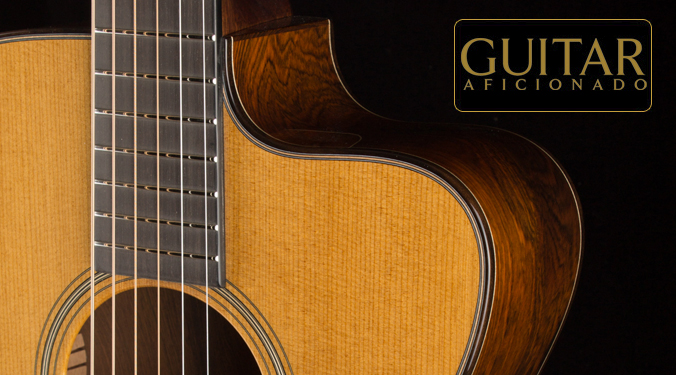Homepage News, Review & Articles
Guitar Aficionado reviews the OMC Soloist
Guitar Aficionado’s Chris Gill reviewed the OMC Soloist this August.
One of the original founding fathers of today’s independent steel-string luthier renaissance, Dana Bourgeois helped the movement gain momentum both with his innovative guitar designs and by giving lectures and writing articles on his influential voicing concepts.
As the co-founder of Schoenberg Guitars in the Eighties, Bourgeois proved that modern-day flattop acoustic guitars could duplicate or even improve upon the tone of the vintage classics. By the time he established Dana Bourgeois Guitars in 1993, he had already developed a devoted following of professional players and acoustic connoisseurs alike.
One of Bourgeois’ most popular and requested designs was a cutaway model based on Martin’s early Thirties OM guitars. This design, called the Soloist, was the original foundation and inspiration for Schoenberg Guitars, but Bourgeois produced the Soloist only on a one-off, custom-order basis. However, a few years ago, he finally added a Soloist model to his regular production, making the model accessible to more players.
The OMC Soloist was designed to provide the well-balanced frequency range and sweet treble that fingerstyle guitarists demand, which can be a challenge to maintain with a cutaway design. Using the classic OM design as a starting point, Bourgeois achieved this goal through the selection of exceptionally fine materials and his own voicing innovations. Our example featured the time-proven tonewood combination of a Swiss spruce top, exquisite Brazilian rosewood back and sides, and a one-piece mahogany neck with an ebony fretboard and early Thirties–style 25 1/2–inch scale length.
The Soloist is conservatively decorated with Brazilian rosewood binding, maple black/white/black purfling on the top, sides, and back, an understated wooden ring rosette, and Bourgeois’ own and often-imitated multicolor herringbone back strip. Inlays consist of the Bourgeois logo on the headstock; short-pattern slotted squares and diamonds at the fifth, seventh, and ninth frets, and a slotted triangle on the neck heel cap. The bridge has a traditional pre-Thirties–style ebony rectangular pyramid design, and the bridge pins are made of gorgeous fossilized mammoth ivory. Tuners are gold-plated, open-gear, vintage-style Waverlys with ebony buttons. The simple, elegant decoration makes the exceptionally high-quality materials the guitar’s main visual focus.
In the player’s hands, the Soloist feels very well balanced and much lighter than one would expect for a modern flattop steel-string acoustic, although it’s a very sturdily built instrument and not overly delicate. The neck profile is relatively slim but with a comfortable curve that fits solidly into the player’s fretting hand. With its 1 ¾-inch nut width, the fretboard is very easy to navigate for most fingerstyle players, who prefer ample space in between strings for fingering chords and single-note lines cleanly. The somewhat conservative cutaway has a very subtle curve and is located between the 16th and 17th frets to provide good access up the neck but without sacrificing excess body volume at the upper bout.
All of these elements combine to provide absolutely stellar tone. I’ve long considered the classic OM design the ultimate fingerstyle guitar, but the OMC Soloist takes those seductive tones to another level altogether. The bass is surprisingly assertive for a midsize cutaway flattop, but the midrange and treble are quite impressively bold and full-bodied as well. Individual notes remain focused and bell-like up and down the neck, and note-to-note definition when strumming chords is outstanding.
Perhaps the most impressive element of the OMC Soloist’s tone is its reverb-like resonance. This is partially thanks to its glorious Brazilian rosewood construction, but Bourgeois’ voicing brings out a certain complexity in the resonance that is elusive in many OM designs. Lush harmonic overtones swell and sustain when slow single-note passages are played, but the sound magically tightens up when chords are strummed with a flatpick. These qualities make the OMC Soloist an exceptionally versatile guitar for performers who employ a variety of playing techniques but prefer to use a single instrument onstage.
LIST PRICE $9,195
Bourgeois Guitars, pantheonguitars.com
Bourgeois Construct: Dana Bourgeois discusses details of the OMC Soloist’s design.
What inspired the decision to finally offer the OMC Soloist as a standard model?
In the early Eighties, I built what I believe was the first OM guitar with a Soloist-style cutaway. By the turn of the millennium, so many other companies had offered similar models that I felt the time was right to reclaim an original design and offer it with its original appointments.
The entire guitar costs less than many companies’ Brazilian rosewood options. How did you keep the price competitive?
We have always worked at cost control. From our humble old mill shop to working hard on wood resources, we strive to deliver value through New England practicalities.
How are your voicing concepts applied in this model’s design?
The Soloist and all other Bourgeois guitars are voiced according to a similar concept. Tops and backs are built to precise cross-grain and long-grain stiffness parameters. Within those parameters, braces are shaped to bring out the widest possible variety of distinct tap tones inherent in the materials selected for an individual guitar. Proper stiffness regulates power and responsiveness, and a wide variety of tap tones insures balanced tone.
– See more at: http://www.guitaraficionado.com/review-bourgeois-guitars-omc-soloist.html#sthash.C30ujwJL.dpuf
Read the full article in PDF form here

